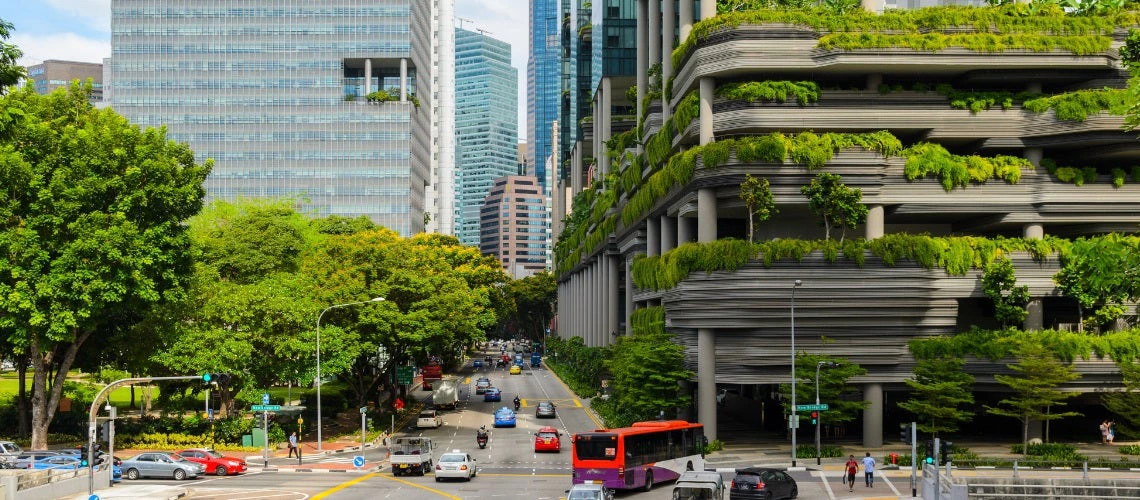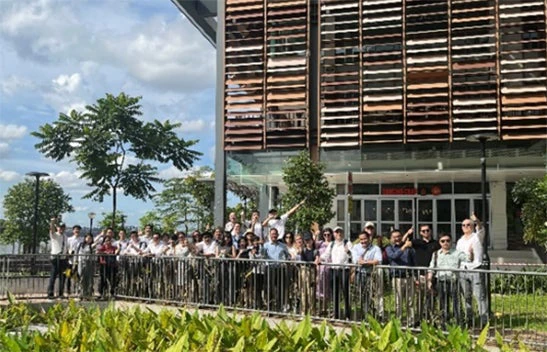 View of green spaces in Singapore
View of green spaces in Singapore
Cities worldwide are grappling with the adverse effects of Urban Heat Island (UHI)[1], intensified by rising global temperatures from climate change. The consequences of the UHI effect extend far beyond discomfort, with profound health and economic implications for cities and their residents. Low-income neighborhoods, communities lacking green spaces, and other marginalized populations bear a disproportionate burden of the economic costs associated with urban heat. Around 20% of total heat-related excess deaths globally between 2000 and 2019 occurred in East Asia , resulting in over 101,000 fatalities. Moreover, the UHI effect results in decreased productivity and higher expenses for cooling buildings, contributing to an increase in carbon emissions.
The world stands at a climate inflection point where collective action and local interventions are key. To mitigate temperature rises due to climate change, longer-term reductions in carbon emissions and international cooperation are warranted. However, UHI effects due to heat absorption by urban infrastructure and heat production by vehicles and appliances can be mitigated by local interventions. Across cities, there is an urgent need to develop sustainable solutions for mitigation and adaptation in response to UHI effects.
Planning for Heat-Resilient Cities
In planning for a livable and heat-resilient city, Singapore has taken measures to mitigate against urban heat and leverage technology and innovation in policy and planning. From 1948 to 2016, the annual mean temperatures in the city-state rose at an average rate of 0.25°C per decade. Daily mean temperatures are projected to increase from 1.4°C to 4.6°C by the end of the century. Compared to forested areas, built-up areas in Singapore are around 0-2°C hotter in the day, and 2-4°C at night.
Facing this head-on, Singapore’s response zeroes in on three fronts:
- Crafting wind corridors and optimizing shade.
- Reducing heat absorption.
- Curtailing heat emissions.
The overarching approach is supported by measurement, modeling, and underpinned by research into various sectors including urban greenery, cool materials, and district cooling among others.
Notable among Singapore’s strategy against urban heat are:
- Urban Greenery: Singapore’s Green Plan 2030 and the City in Nature vision ensure an additional 1000ha of green space will be set aside within 10 to 15 years, with every residence within a 10-minute walk to a park by 2030.
- Skyrise Greening: encouraged since 2009 via the Landscaping for Urban Spaces and High-Rises (LUSH) scheme, has introduced over 300ha of greenery in new developments. Vertical greenery on building facades plays a crucial role, offering shade, reducing energy bills, and enhancing pedestrian comfort. Shading buildings with vertical greenery leads to significant reductions of 10 to 31% in energy cooling load, with the cooling influence extending up to one meter from the green wall.
- Innovative Materials: Pilot projects use cool paints in public housing residential estates, impacting close to 80% of the population. Preliminary findings show that cool paint coatings can reduce ambient temperatures around buildings by up to 2°C.
Additionally, the Digital Urban Climate Twin (DUCT) aims to model scenarios in areas with higher temperatures, including the introduction of new parks and open spaces.
Technical Deep Dive on Urban Heat in Singapore
To foster knowledge exchange on effective strategies, the World Bank organized a Technical Deep Dive (TDD) on Urban Heat in April 2023, in Singapore. With participants from East Asia including China, Indonesia, Cambodia, Philippines, Vietnam, and Thailand, as well as Poland and Uzbekistan representing Europe and Central Asia, the deep dive offered a platform to explore best practices and case studies from cities like Singapore, Paris, and Guangzhou.
The five-day program focused on incorporating climate adaptation and cooling solutions into planning a holistic approach to urban cooling solutions including nature-based solutions, financing mechanisms, and integrating these solutions into tangible policies. The program was structured to highlight the process and approach to tackling urban heat challenges and provide a platform for deep-structured collaborative learning.
Impacts on Urban Heat Management
Though urban cooling remains a novel subject for many participating cities, there is consensus among participants on the need for a deeper understanding of the consequences of urban heatwaves on health, urban infrastructure, and natural resources. Many cities are not prepared to cope with a much warmer climate, making raising awareness of the effects of urban heat crucial to mobilizing financing tools for mitigation and reduction.
To better equip cities in addressing challenges posed by a warming world, the deep-dive sessions highlighted common solutions including harnessing data to create urban heatmaps, fostering coordination and integration across public-private-people sectors, adapting and localizing passive and active cooling techniques, as well as incorporating these solutions into building codes, standards, and policies.
By adopting these innovative solutions, cities can better prepare themselves to cope with the impacts of global heating and work towards creating more heat-resilient and livable urban environments.
More information on the Technical Deep Dive on Urban Heat may be found on the Global Platform for Sustainable Cities website.
[1] The urban heat island effect refers to the phenomenon where urban areas experience higher temperatures than surrounding rural areas due to the absorption and retention of heat by buildings, roads, and other infrastructure.



Join the Conversation